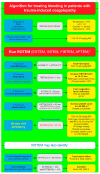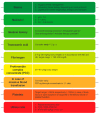Management of Coagulopathy in Bleeding Patients
- PMID: 35011742
- PMCID: PMC8745606
- DOI: 10.3390/jcm11010001
Management of Coagulopathy in Bleeding Patients
Abstract
Early recognition of coagulopathy is necessary for its prompt correction and successful management. Novel approaches, such as point-of-care testing (POC) and administration of coagulation factor concentrates (CFCs), aim to tailor the haemostatic therapy to each patient and thus reduce the risks of over- or under-transfusion. CFCs are an effective alternative to ratio-based transfusion therapies for the correction of different types of coagulopathies. In case of major bleeding or urgent surgery in patients treated with vitamin K antagonist anticoagulants, prothrombin complex concentrate (PCC) can effectively reverse the effects of the anticoagulant drug. Evidence for PCC effectiveness in the treatment of direct oral anticoagulants-associated bleeding is also increasing and PCC is recommended in guidelines as an alternative to specific reversal agents. In trauma-induced coagulopathy, fibrinogen concentrate is the preferred first-line treatment for hypofibrinogenaemia. Goal-directed coagulation management algorithms based on POC results provide guidance on how to adjust the treatment to the needs of the patient. When POC is not available, concentrate-based management can be guided by other parameters, such as blood gas analysis, thus providing an important alternative. Overall, tailored haemostatic therapies offer a more targeted approach to increase the concentration of coagulation factors in bleeding patients than traditional transfusion protocols.
Keywords: acquired coagulopathy; anticoagulation reversal; coagulation factor concentrate; goal-directed coagulation management; haemostasis; viscoelastic testing.
Conflict of interest statement
S.H., S.C. and E.G. have received speaker/consultancy honoraria from CSL Behring. C.J.S. has received speaker/consultancy honoraria from CSL Behring, Boehringer Ingelheim, Portola, Shionogi and research support from TEM Innovation.
Figures



References
-
- Tanaka K., Bolliger D. Reference Module in Biomedical Sciences. Elsevier; Amsterdam, The Netherlands: 2014. Acquired coagulopathy. - DOI
Publication types
LinkOut - more resources
Full Text Sources

